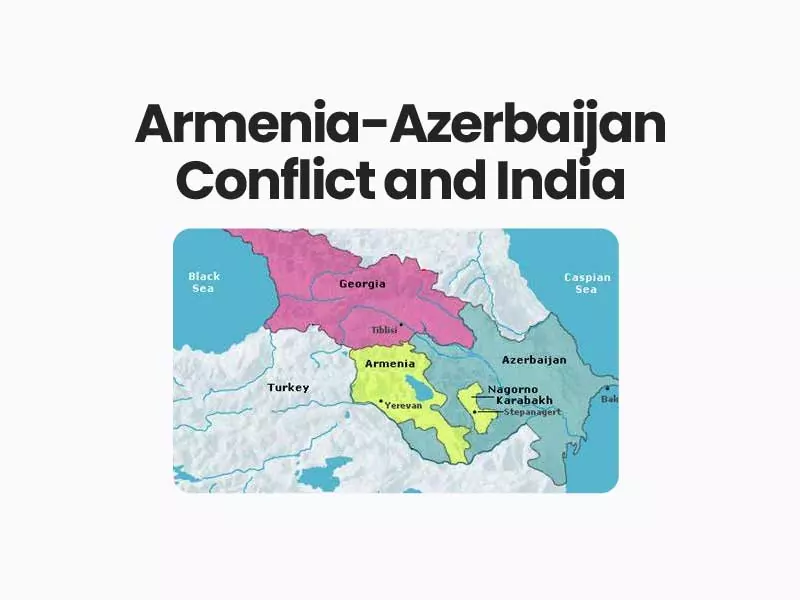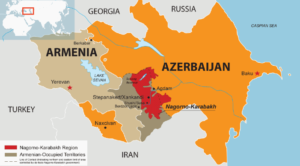Companion@360 → 7 Month programme to sharpen your writing skills → REGISTER NOW

Armenia-Azerbaijan Conflict and India
A three-decades-old unresolved ethnos territorial conflict between Armenia and Azerbaijan over Nagorno-Karabakh flared up once again. The conflict is between two relatively small countries and is territorial in nature.
Origin of the conflict:
Nagorno-Karabakh is a mountainous and heavily forested patch of land that sits inside the territory of the former Soviet republic of Azerbaijan.
Under international law, Nagorno-Karabakh is recognized as part of Azerbaijan, but the ethnic Armenians who make up the vast majority of the population reject Azeri rule.
They have been running their own affairs, with support from Armenia, since Azerbaijan`s troops were pushed out in a war in the 1990s.
The Caucasus is a strategically important mountainous region in south-east Europe. For centuries, different powers in the region – both Christian and Muslim – have vied for control there.
Nagorno-Karabakh – key facts:
A mountainous region of about 4,400 sq km (1,700 sq miles)
Traditionally inhabited by Christian Armenians and Muslim Turks
In Soviet times, it became an autonomous region within the republic of Azerbaijan
Internationally recognized as part of Azerbaijan, but majority of population is ethnic Armenian
An estimated one million people displaced by war in 1988-1994, and about 30,000 killed
Separatist forces captured some extra territory around the enclave in Azerbaijan in the 1990s war
Stalemate has largely prevailed since a 1994 ceasefire
Turkey openly supports Azerbaijan;
Russia has military bases in Armenia
Israel: The conflict marks a strange coupling of Turkey and Israel, which are hostile to one another both diplomatically and in terms of security.
Significance of the region:
The energy-rich Azerbaijan has built several gas and oil pipelines across the Caucasus (the region between the Black Sea and the Caspian Sea) to Turkey and Europe.
Some of these pipelines pass close to the conflict zone (within 16 km of the border).
In an open war between the two countries, the pipelines could be targeted, which would impact energy supplies and may even lead to higher oil prices globally.
Role of India:
India does not have a publicly articulated policy for South Caucasus, unlike ‘Neighborhood First’, ‘Act East’ or ‘Central Asia Connect’ policies and the region has remained only on the periphery of its radar.
Balancing Between The Two Extremes
India has adopted a balanced and neutral stance and made a politically correct statement in which it has expressed its concern, called for restraint and immediate cessation of hostilities and resolution of the conflict peacefully through diplomatic negotiations.
Asymmetry in Relations
There is a visible asymmetry in India’s relations with Armenia, Azerbaijan, and Georgia.
Armenia is the only country in the region with which it has a Friendship and Cooperation Treaty (signed in 1995), which incidentally would prohibit India from providing military or any other assistance to Azerbaijan in case Azerbaijan’s offensive in Nagorno-Karabakh spills over to the territory of Armenia.
Conclusion
The conflict between the two countries has reached alarming levels and the international mediators should intervene immediately and push sides for substantive negotiations to prevent any further escalations.
Growing Pakistan- China-Turkey’s influence in the south Caucasus region is a source of concern for India. It is important for it to strengthen its ties with both the countries in line continuing its non-aligned stance and call for peace in the region.
Under these circumstances, India has done the right thing to adopt a balanced and neutral stance and pitching for a political solution as outlined in the Madrid Principles.
Read Also India Afghanistan Relations

